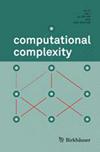The complexity of approximating the complex-valued Potts model
IF 1
3区 计算机科学
Q3 COMPUTER SCIENCE, THEORY & METHODS
引用次数: 4
Abstract
We study the complexity of approximating the partition function of the q-state Potts model and the closely related Tutte polynomial for complex values of the underlying parameters. Apart from the classical connections with quantum computing and phase transitions in statistical physics, recent work in approximate counting has shown that the behaviour in the complex plane, and more precisely the location of zeros, is strongly connected with the complexity of the approximation problem, even for positive real-valued parameters. Previous work in the complex plane by Goldberg and Guo focused on q = 2, which corresponds to the case of the Ising model; for q > 2, the behaviour in the complex plane is not as well understood and most work applies only to the real-valued Tutte plane. Our main result is a complete classification of the complexity of the approximation problems for all non-real values of the parameters, by establishing #P-hardness results that apply even when restricted to planar graphs. Our techniques apply to all q $$\geq$$ ≥ 2 and further complement/refine previous results both for the Ising model and the Tutte plane, answering in particular a question raised by Bordewich, Freedman, Lovász and Welsh in the context of quantum computations.逼近复值波茨模型的复杂性
我们研究了q态Potts模型配分函数的逼近复杂性,以及与之密切相关的底层参数复值的Tutte多项式。除了与量子计算和统计物理中的相变的经典联系外,最近在近似计数方面的工作表明,复平面中的行为,更准确地说是零点的位置,与近似问题的复杂性密切相关,即使是正实值参数。Goldberg和Guo之前在复平面上的工作集中在q = 2上,这与Ising模型的情况相对应;对于q>2,在复平面上的行为不是很好理解,大多数工作只适用于实值Tutte平面。我们的主要结果是通过建立即使局限于平面图也适用的# p -硬度结果,对参数的所有非实值的近似问题的复杂性进行了完整的分类。我们的技术适用于所有q $$\geq$$≥2,并进一步补充/完善了先前的Ising模型和Tutte平面的结果,特别是回答了由Bordewich, Freedman, Lovász和Welsh在量子计算背景下提出的问题。
本文章由计算机程序翻译,如有差异,请以英文原文为准。
求助全文
约1分钟内获得全文
求助全文
来源期刊

Computational Complexity
数学-计算机:理论方法
CiteScore
1.50
自引率
0.00%
发文量
16
审稿时长
>12 weeks
期刊介绍:
computational complexity presents outstanding research in computational complexity. Its subject is at the interface between mathematics and theoretical computer science, with a clear mathematical profile and strictly mathematical format.
The central topics are:
Models of computation, complexity bounds (with particular emphasis on lower bounds), complexity classes, trade-off results
for sequential and parallel computation
for "general" (Boolean) and "structured" computation (e.g. decision trees, arithmetic circuits)
for deterministic, probabilistic, and nondeterministic computation
worst case and average case
Specific areas of concentration include:
Structure of complexity classes (reductions, relativization questions, degrees, derandomization)
Algebraic complexity (bilinear complexity, computations for polynomials, groups, algebras, and representations)
Interactive proofs, pseudorandom generation, and randomness extraction
Complexity issues in:
crytography
learning theory
number theory
logic (complexity of logical theories, cost of decision procedures)
combinatorial optimization and approximate Solutions
distributed computing
property testing.
 求助内容:
求助内容: 应助结果提醒方式:
应助结果提醒方式:


